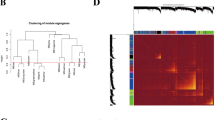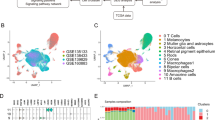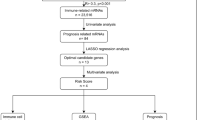Abstract
Purpose
Uveal melanoma (UVM) is a rare yet malignant ocular tumor that metastases in approximately half of all patients, with the majority of those developing metastasis typically succumbing to the disease within a year. Hitherto, no effective treatment for UVM has been identified. Autophagy is a cellular mechanism that has been suggested as an emerging regulatory process for cancer-targeted therapy. Thus, identifying novel prognostic biomarkers of autophagy may help improve future treatment.
Methods
Consensus clustering and similarity network fusion approaches were performed for classifying UVM patient subgroups. Weighted correlation network analysis was performed for gene module screening and network construction. Gene set variation analysis was used to evaluate the autophagy activity of the UVM subgroups. Kaplan–Meier survival curves (Log-rank test) were performed to analyze patient prognosis. Gene set cancer analysis was used to estimate the level of immune cell infiltration.
Results
In this study, we employed multi-omics approaches to classify UVM patient subgroups by molecular and clinical characteristics, ultimately identifying HTR2B, EEF1A2, FEZ1, GRID1, HAP1, and SPHK1 as potential prognostic biomarkers of autophagy in UVM. High expression levels of these markers were associated with poorer patient prognosis and led to reshaping the tumor microenvironment (TME) that promotes tumor progression.
Conclusion
We identified six novel potential prognostic biomarkers in UVM, all of which are associated with autophagy and TME. These findings will shed new light on UVM therapy with inhibitors targeting these biomarkers expected to regulate autophagy and reshape the TME, significantly improving UVM treatment outcomes.







Similar content being viewed by others
Data availability
The datasets analyzed during the current study are available in the UCSC Xena repository, (https://xenabrowser.net/).
Abbreviations
- CNV:
-
Copy number variation
- DSS:
-
Disease-specific survival
- GSCA:
-
Gene set cancer analysis
- GSEA:
-
Gene set enrichment analysis
- GSVA:
-
Gene set variation analysis
- MAD:
-
Median absolute deviation
- OS:
-
Overall survival
- PFI:
-
Progression-free interval
- SNF:
-
Similarity network fusion
- TCGA:
-
The Cancer Genome Atlas
- TME:
-
Tumor microenvironment
- UVM:
-
Uveal melanoma
- WGCNA:
-
Weighted correlation network analysis
References
Álvarez-Rodríguez B, Latorre A, Posch C, Somoza Á (2017) Recent advances in uveal melanoma treatment. Med Res Rev 37:1350–1372. https://doi.org/10.1002/med.21460
Burada AP, Vinnakota R, Kumar J (2020) Cryo-EM structures of the ionotropic glutamate receptor GluD1 reveal a non-swapped architecture. Nat Struct Mol Biol 27:84–91. https://doi.org/10.1038/s41594-019-0359-y
Carvajal RD, Butler MO, Shoushtari AN, Hassel JC, Ikeguchi A, Hernandez-Aya L, Nathan P, Hamid O, Piulats JM, Rioth M, Johnson DB, Luke JJ, Espinosa E, Leyvraz S, Collins L, Goodall HM, Ranade K, Holland C, Abdullah SE, Sacco JJ, Sato T (2022) Clinical and molecular response to tebentafusp in previously treated patients with metastatic uveal melanoma: a phase 2 trial. Nat Med 28:2364–2373. https://doi.org/10.1038/s41591-022-02015-7
Carvajal RD, Sacco JJ, Jager MJ, Eschelman DJ, OlofssonBagge R, Harbour JW, Chieng ND, Patel SP, Joshua AM, Piperno-Neumann S (2023) Advances in the clinical management of uveal melanoma. Nat Rev Clin Oncol 20:99–115. https://doi.org/10.1038/s41571-022-00714-1
Chandran SS, Somerville RPT, Yang JC, Sherry RM, Klebanoff CA, Goff SL, Wunderlich JR, Danforth DN, Zlott D, Paria BC, Sabesan AC, Srivastava AK, Xi L, Pham TH, Raffeld M, White DE, Toomey MA, Rosenberg SA, Kammula US (2017) Treatment of metastatic uveal melanoma with adoptive transfer of tumour-infiltrating lymphocytes: a single-centre, two-stage, single-arm, phase 2 study. Lancet Oncol 18:792–802. https://doi.org/10.1016/s1470-2045(17)30251-6
Chattopadhyay C, Kim DW, Gombos DS, Oba J, Qin Y, Williams MD, Esmaeli B, Grimm EA, Wargo JA, Woodman SE, Patel SP (2016) Uveal melanoma: from diagnosis to treatment and the science in between. Cancer 122:2299–2312. https://doi.org/10.1002/cncr.29727
Chen X, Wu Q, Depeille P, Chen P, Thornton S, Kalirai H, Coupland SE, Roose JP, Bastian BC (2017) RasGRP3 mediates MAPK pathway activation in GNAQ mutant uveal melanoma. Cancer Cell 31:685-696.e6. https://doi.org/10.1016/j.ccell.2017.04.002
Chen HT, Liu H, Mao MJ, Tan Y, Mo XQ, Meng XJ, Cao MT, Zhong CY, Liu Y, Shan H, Jiang GM (2019a) Crosstalk between autophagy and epithelial-mesenchymal transition and its application in cancer therapy. Mol Cancer 18:101. https://doi.org/10.1186/s12943-019-1030-2
Chen Y, Wang G, Cai H, Sun Y, Ouyang L, Liu B (2019b) Deciphering the rules of in silico autophagy methods for expediting medicinal research. J Med Chem 62:6831–6842. https://doi.org/10.1021/acs.jmedchem.8b01673
Conway JR, Lex A, Gehlenborg N (2017) UpSetR: an R package for the visualization of intersecting sets and their properties. Bioinformatics 33:2938–2940. https://doi.org/10.1093/bioinformatics/btx364
Galluzzi L, Bravo-San Pedro JM, Demaria S, Formenti SC, Kroemer G (2017) Activating autophagy to potentiate immunogenic chemotherapy and radiation therapy. Nat Rev Clin Oncol 14:247–258. https://doi.org/10.1038/nrclinonc.2016.183
Gao W, Wang X, Zhou Y, Wang X, Yu Y (2022) Autophagy, ferroptosis, pyroptosis, and necroptosis in tumor immunotherapy. Signal Transduct Target Ther 7:196. https://doi.org/10.1038/s41392-022-01046-3
Guhan S, Klebanov N, Tsao H (2021) Melanoma genomics: a state-of-the-art review of practical clinical applications. Br J Dermatol 185:272–281. https://doi.org/10.1111/bjd.20421
Hänzelmann S, Castelo R, Guinney J (2013) GSVA: gene set variation analysis for microarray and RNA-seq data. BMC Bioinform 14:7. https://doi.org/10.1186/1471-2105-14-7
Hasin Y, Seldin M, Lusis A (2017) Multi-omics approaches to disease. Genome Biol 18:83. https://doi.org/10.1186/s13059-017-1215-1
Huang A, Garraway LA, Ashworth A, Weber B (2020) Synthetic lethality as an engine for cancer drug target discovery. Nat Rev Drug Discov 19:23–38. https://doi.org/10.1038/s41573-019-0046-z
Hutchinson L (2017) Immunotherapy: cul-TIL-vating uveal melanoma regression. Nat Rev Clin Oncol 14:328–329. https://doi.org/10.1038/nrclinonc.2017.61
Jager MJ, Shields CL, Cebulla CM, Abdel-Rahman MH, Grossniklaus HE, Stern MH, Carvajal RD, Belfort RN, Jia R, Shields JA, Damato BE (2020) Uveal melanoma. Nat Rev Dis Primers 6:24. https://doi.org/10.1038/s41572-020-0158-0
Jia L, Ge X, Du C, Chen L, Zhou Y, Xiong W, Xiang J, Li G, Xiao G, Fang L, Li Z (2021) EEF1A2 interacts with HSP90AB1 to promote lung adenocarcinoma metastasis via enhancing TGF-β/SMAD signalling. Br J Cancer 124:1301–1311. https://doi.org/10.1038/s41416-020-01250-4
Jiang SH, Li J, Dong FY, Yang JY, Liu DJ, Yang XM, Wang YH, Yang MW, Fu XL, Zhang XX, Li Q, Pang XF, Huo YM, Li J, Zhang JF, Lee HY, Lee SJ, Qin WX, Gu JR, Sun YW, Zhang ZG (2017) Increased serotonin signaling contributes to the Warburg effect in pancreatic tumor cells under metabolic stress and promotes growth of pancreatic tumors in mice. Gastroenterology 153:277-291.e19. https://doi.org/10.1053/j.gastro.2017.03.008
Jin B, Zhang P, Zou H, Ye H, Wang Y, Zhang J, Yang H, Pan J (2020) Verification of EZH2 as a druggable target in metastatic uveal melanoma. Mol Cancer 19:52. https://doi.org/10.1186/s12943-020-01173-x
Langfelder P, Horvath S (2008) WGCNA: an R package for weighted correlation network analysis. BMC Bioinformatics 9:559. https://doi.org/10.1186/1471-2105-9-559
Lee JK, Kang S, Wang X, Rosales JL, Gao X, Byun HG, Jin Y, Fu S, Wang J, Lee KY (2019) HAP1 loss confers l-asparaginase resistance in ALL by downregulating the calpain-1-Bid-caspase-3/12 pathway. Blood 133:2222–2232. https://doi.org/10.1182/blood-2018-12-890236
Levy JMM, Towers CG, Thorburn A (2017) Targeting autophagy in cancer. Nat Rev Cancer 17:528–542. https://doi.org/10.1038/nrc.2017.53
Li P, He J, Yang Z, Ge S, Zhang H, Zhong Q, Fan X (2020) ZNNT1 long noncoding RNA induces autophagy to inhibit tumorigenesis of uveal melanoma by regulating key autophagy gene expression. Autophagy 16:1186–1199. https://doi.org/10.1080/15548627.2019.1659614
Lin Y, Qian F, Shen L, Chen F, Chen J, Shen B (2019) Computer-aided biomarker discovery for precision medicine: data resources, models and applications. Brief Bioinform 20:952–975. https://doi.org/10.1093/bib/bbx158
Liu B, Yao X, Zhang C, Liu Y, Wei L, Huang Q, Wang M, Zhang Y, Hu D, Wu W (2023a) PTK6 inhibits autophagy to promote uveal melanoma tumorigenesis by binding to SOCS3 and regulating mTOR phosphorylation. Cell Death Dis 14:55. https://doi.org/10.1038/s41419-023-05590-w
Liu CJ, Hu FF, Xie GY, Miao YR, Li XW, Zeng Y, Guo AY (2023b) GSCA: an integrated platform for gene set cancer analysis at genomic, pharmacogenomic and immunogenomic levels. Brief Bioinform. https://doi.org/10.1093/bib/bbac558
Miao YR, Zhang Q, Lei Q, Luo M, Xie GY, Wang H, Guo AY (2020) ImmuCellAI: a unique method for comprehensive T-cell subsets abundance prediction and its application in cancer immunotherapy. Adv Sci (Weinh) 7:1902880. https://doi.org/10.1002/advs.201902880
Mizushima N, Levine B (2020) Autophagy in human diseases. N Engl J Med 383:1564–1576. https://doi.org/10.1056/NEJMra2022774
Parker T, Rigney G, Kallos J, Stefko ST, Kano H, Niranjan A, Green AL, Aziz T, Rath P, Lunsford LD (2020) Gamma knife radiosurgery for uveal melanomas and metastases: a systematic review and meta-analysis. Lancet Oncol 21:1526–1536. https://doi.org/10.1016/s1470-2045(20)30459-9
Ponti A, Denys A, Digklia A, Schaefer N, Hocquelet A, Knebel JF, Michielin O, Dromain C, Duran R (2020) First-line selective internal radiation therapy in patients with uveal melanoma metastatic to the liver. J Nucl Med 61:350–356. https://doi.org/10.2967/jnumed.119.230870
Qadir F, Aziz MA, Sari CP, Ma H, Dai H, Wang X, Raithatha D, Da Silva LGL, Hussain M, Poorkasreiy SP, Hutchison IL, Waseem A, Teh MT (2018) Transcriptome reprogramming by cancer exosomes: identification of novel molecular targets in matrix and immune modulation. Mol Cancer 17:97. https://doi.org/10.1186/s12943-018-0846-5
Robertson AG, Shih J, Yau C, Gibb EA, Oba J, Mungall KL, Hess JM, Uzunangelov V, Walter V, Danilova L, Lichtenberg TM, Kucherlapati M, Kimes PK, Tang M, Penson A, Babur O, Akbani R, Bristow CA, Hoadley KA, Iype L, Chang MT, Cherniack AD, Benz C, Mills GB, Verhaak RGW, Griewank KG, Felau I, Zenklusen JC, Gershenwald JE, Schoenfield L, Lazar AJ, Abdel-Rahman MH, Roman-Roman S, Stern MH, Cebulla CM, Williams MD, Jager MJ, Coupland SE, Esmaeli B, Kandoth C, Woodman SE (2017) Integrative analysis identifies four molecular and clinical subsets in uveal melanoma. Cancer Cell 32:204-220.e15. https://doi.org/10.1016/j.ccell.2017.07.003
Shannon P, Markiel A, Ozier O, Baliga NS, Wang JT, Ramage D, Amin N, Schwikowski B, Ideker T (2003) Cytoscape: a software environment for integrated models of biomolecular interaction networks. Genome Res 13:2498–2504. https://doi.org/10.1101/gr.1239303
Shields CL, Shields JA, Perez N, Singh AD, Cater J (2002) Primary transpupillary thermotherapy for small choroidal melanoma in 256 consecutive cases: outcomes and limitations. Ophthalmology 109:225–234. https://doi.org/10.1016/s0161-6420(01)00902-2
Smit KN, Jager MJ, de Klein A, Kiliҫ E (2020) Uveal melanoma: Towards a molecular understanding. Prog Retin Eye Res 75:100800. https://doi.org/10.1016/j.preteyeres.2019.100800
Subramanian A, Tamayo P, Mootha VK, Mukherjee S, Ebert BL, Gillette MA, Paulovich A, Pomeroy SL, Golub TR, Lander ES, Mesirov JP (2005) Gene set enrichment analysis: a knowledge-based approach for interpreting genome-wide expression profiles. Proc Natl Acad Sci U S A 102:15545–15550. https://doi.org/10.1073/pnas.0506580102
Tian L, Wu Y, Choi HJ, Sui X, Li X, Sofi MH, Kassir MF, Chen X, Mehrotra S, Ogretmen B, Yu XZ (2022) S1P/S1PR1 signaling differentially regulates the allogeneic response of CD4 and CD8 T cells by modulating mitochondrial fission. Cell Mol Immunol 19:1235–1250. https://doi.org/10.1038/s41423-022-00921-x
Truong A, Yoo JH, Scherzer MT, Sanchez JMS, Dale KJ, Kinsey CG, Richards JR, Shin D, Ghazi PC, Onken MD, Blumer KJ, Odelberg SJ, McMahon M (2020) Chloroquine sensitizes GNAQ/11-mutated melanoma to MEK1/2 inhibition. Clin Cancer Res 26:6374–6386. https://doi.org/10.1158/1078-0432.Ccr-20-1675
Wang B, Mezlini AM, Demir F, Fiume M, Tu Z, Brudno M, Haibe-Kains B, Goldenberg A (2014) Similarity network fusion for aggregating data types on a genomic scale. Nat Methods 11:333–337. https://doi.org/10.1038/nmeth.2810
Wilkerson MD, Hayes DN (2010) ConsensusClusterPlus: a class discovery tool with confidence assessments and item tracking. Bioinformatics 26:1572–1573. https://doi.org/10.1093/bioinformatics/btq170
Wu L, Jin W, Yu H, Liu B (2023) Modulating autophagy to treat diseases: a revisited review on in silico methods. J Adv Res. https://doi.org/10.1016/j.jare.2023.05.002
Xia H, Green DR, Zou W (2021) Autophagy in tumour immunity and therapy. Nat Rev Cancer 21:281–297. https://doi.org/10.1038/s41568-021-00344-2
Xu T, Le TD, Liu L, Su N, Wang R, Sun B, Colaprico A, Bontempi G, Li J (2017) CancerSubtypes: an R/Bioconductor package for molecular cancer subtype identification, validation and visualization. Bioinformatics 33:3131–3133. https://doi.org/10.1093/bioinformatics/btx378
Acknowledgements
The authors would like to thank all the researchers and study participants for their contributions.
Funding
The authors declare that no funds, grants, or other support were received during the preparation of this manuscript.
Author information
Authors and Affiliations
Contributions
KM contributed to the study's conception and design. YM polished the manuscript. Material preparation, data collection, and analysis were performed by WJ. The first draft of the manuscript was written by WJ, LW, and LH; and all authors commented on previous versions of the manuscript. All authors read and approved the final manuscript.
Corresponding authors
Ethics declarations
Conflict of interest
The authors declare that they have no competing financial interests.
Additional information
Publisher's Note
Springer Nature remains neutral with regard to jurisdictional claims in published maps and institutional affiliations.
Supplementary Information
Below is the link to the electronic supplementary material.
Rights and permissions
Springer Nature or its licensor (e.g. a society or other partner) holds exclusive rights to this article under a publishing agreement with the author(s) or other rightsholder(s); author self-archiving of the accepted manuscript version of this article is solely governed by the terms of such publishing agreement and applicable law.
About this article
Cite this article
Jin, W., Wu, L., Hu, L. et al. Multi-omics approaches identify novel prognostic biomarkers of autophagy in uveal melanoma. J Cancer Res Clin Oncol 149, 16691–16703 (2023). https://doi.org/10.1007/s00432-023-05401-x
Received:
Accepted:
Published:
Issue Date:
DOI: https://doi.org/10.1007/s00432-023-05401-x




